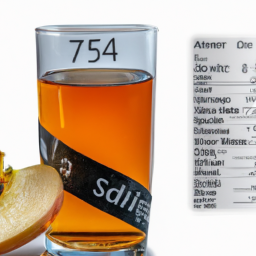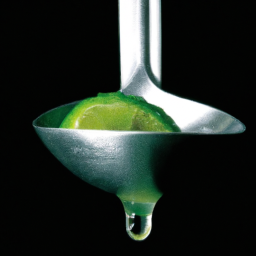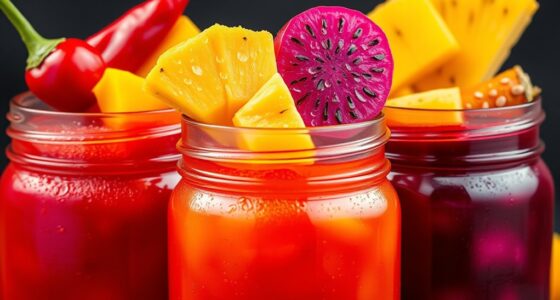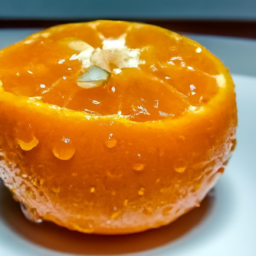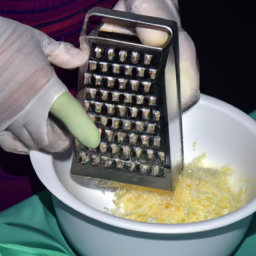As someone who is conscious of what I eat, I often think about the nutritional content of the beverages I drink. I have a fondness for apple juice, but I have always been curious about how many calories it contains. With this in mind, I decided to do some research and find out the exact caloric content of apple juice.
In this article, I will share my findings and provide information on the nutritional content, serving size, and caloric value of apple juice, as well as the health benefits and potential risks associated with consuming it.
Apple juice is a popular beverage that is enjoyed by people of all ages. It is known for its sweet taste and refreshing qualities, but many people are unaware of its nutritional value. In this article, I will aim to shed light on the nutritional content of apple juice, including its calorie count.
By providing this information, I hope to help readers make informed choices about their beverage consumption and better understand the impact of apple juice on their overall health and wellbeing.
Key Takeaways
- Apple juice is a good source of vitamin C and potassium, and contains natural sugars for a quick energy boost.
- A typical serving size of apple juice is 8 fluid ounces or 240 milliliters, containing about 120 calories.
- Apple juice should be consumed in moderation due to high sugar content and potential for weight gain and other health concerns.
- Water is a great low-calorie option for hydration, and is the best option for aiding in digestion.
Nutritional Content of Apple Juice
If you’re curious about the nutritional content of apple juice, you’ll be happy to know that it’s packed with vitamins and minerals! Apple juice is a good source of vitamin C, which is an antioxidant that helps protect your cells from damage. It also contains potassium, a mineral that helps regulate blood pressure and supports healthy heart function.
Additionally, apple juice is a good source of natural sugars, which can provide a quick energy boost. In terms of health effects, drinking apple juice has been linked to a reduced risk of certain diseases, such as heart disease and cancer. Some studies have also suggested that apple juice may help improve cognitive function and prevent age-related decline in brain function.
However, it’s important to keep in mind that apple juice also contains natural sugars, which can contribute to weight gain if consumed in excess. With that being said, let’s take a look at the serving size and caloric value of apple juice.
Serving Size and Caloric Value
When sipping on a glass of this sweet nectar, it’s important to keep in mind the serving size and the impact it can have on your daily energy intake. A typical serving size of apple juice is 8 fluid ounces or 240 milliliters, which contains about 120 calories.
This means that if you were to drink a 16-ounce bottle of apple juice, you would consume 240 calories just from that one beverage alone. Aside from calories, apple juice also contains other important nutrients such as vitamin C, potassium, and antioxidants.
However, it’s important to balance the nutritional value with the serving size to ensure you’re not consuming too many calories in one sitting. By being mindful of the serving size and nutritional value, you can still enjoy the delicious taste of apple juice while maintaining a healthy diet.
When comparing apple juice to other common beverages, it’s important to note that it generally contains more calories than water, unsweetened tea, or black coffee. However, it may contain fewer calories than soda or sports drinks.
By understanding the caloric value of different beverages, you can make informed choices about what to drink throughout the day.
Comparison to Other Common Beverages
When it comes to choosing a beverage, there are many options to consider. As someone who’s mindful of their caloric intake, I often compare the caloric value of my options.
Soda, for example, is notoriously high in calories and sugar. Sports drinks can also be calorie-dense, but may be more appropriate for those engaging in intense physical activity.
Alternatively, water is a great low-calorie option that can help keep you hydrated without adding extra calories to your diet.
Soda
Soda lovers, you might want to reconsider your drink choice if you’re looking to cut down on calories. Not only does soda contain high amounts of sugar, but it’s also been linked to negative health effects. These include weight gain, tooth decay, and an increased risk for diabetes and heart disease. In addition, soda has a high addiction potential due to its caffeine and sugar content. This makes it difficult for individuals to cut back or stop consumption.
If you’re someone who enjoys the carbonation and sweetness of soda, consider switching to a healthier alternative. This could be sparkling water with a splash of fruit juice or unsweetened iced tea. By making this simple switch, you can significantly reduce your daily calorie intake and improve your overall health.
Now, let’s take a look at another common beverage, sports drinks, and their calorie content.
Sports Drinks
If you’re looking for a way to hydrate after a workout, sports drinks may seem like a good option. These drinks are marketed towards athletes and claim to replenish electrolytes lost during physical activity. However, it’s important to be aware of their sugar content.
A 20-ounce bottle of a popular sports drink can contain up to 34 grams of sugar, which is equivalent to 8.5 teaspoons. Consuming too much sugar can lead to weight gain and other health issues.
Sports drink alternatives include coconut water, which is high in potassium and electrolytes, and watermelon juice, which contains the amino acid L-citrulline that can help reduce muscle soreness. Additionally, consuming a balanced diet that includes fruits and vegetables can help replenish electrolytes naturally.
Hydration for athletes is important, but choosing the right drink can make a big difference in overall health and performance. When it comes to hydration, water is the best option. Not only is it calorie-free and readily available, but it also helps regulate body temperature and aids in digestion.
It’s important to drink water before, during, and after physical activity to ensure proper hydration. While sports drinks may seem like a convenient option, they should be consumed in moderation and only when necessary.
Water
Drinking enough water is essential for overall health and hydration. It’s especially important to make sure you drink enough water during the summer months or when you’re exercising. Water helps to regulate your body temperature, carries oxygen and nutrients to your cells, and removes waste from your body. It can also help you feel full, which can reduce your overall calorie intake.
While some may argue that water is tasteless or boring, adding a slice of lemon or cucumber can provide a refreshing twist that can make it more enjoyable to drink.
In addition to the hydration benefits, drinking enough water can also improve your overall health. It can help prevent headaches, muscle cramps, and fatigue. It can also help reduce the risk of kidney stones and urinary tract infections.
To ensure that you’re drinking enough water, aim for at least 8-10 cups per day. If you struggle to drink plain water, try adding some fruit or herbal tea to your water bottle to add some flavor.
Drinking apple juice is another way to stay hydrated and reap the health benefits of fruit.
Health Benefits of Apple Juice
Consuming apple juice can provide various health benefits, such as aiding in digestion and boosting the immune system. Apple juice contains a high amount of fiber, which can help regulate bowel movements and prevent constipation.
Additionally, the antioxidants in apple juice may help protect against inflammation and reduce the risk of chronic diseases, such as heart disease and cancer. Furthermore, the polyphenols in apple juice may also have a positive effect on the immune system.
Studies have shown that these compounds can help increase the production of white blood cells, which are responsible for fighting off infections and diseases. However, it’s important to note that apple juice should be consumed in moderation, as it’s also high in sugar and can lead to weight gain and other health concerns.
Risks and Concerns
As I researched the risks and concerns associated with apple juice consumption, I learned that it has a high sugar content. This can lead to dental health issues, such as cavities and decay.
Additionally, frequent consumption of apple juice may contribute to weight gain. It’s important to be mindful of these potential drawbacks when considering incorporating apple juice into your diet.
High Sugar Content
You’ll be surprised by the high sugar content found in most brands of apple juice. While it’s true that apple juice contains some natural sugars, many commercial brands add additional sugar to make it taste sweeter.
Here are a few things to keep in mind when it comes to apple juice and sugar:
- A typical 8-ounce serving of apple juice contains around 30 grams of sugar, which is equivalent to 7.5 teaspoons of sugar.
- Consuming too much sugar can lead to a variety of health problems, such as obesity, diabetes, and heart disease.
- If you’re looking to reduce your sugar intake, consider drinking water or unsweetened beverages instead. Alternatively, you could try diluting your apple juice with water to cut down on the sugar content.
In addition to the health risks associated with consuming too much sugar, high sugar intake can also harm your dental health. When sugar is consumed, it feeds the bacteria in your mouth, which produces acid that can erode your teeth over time.
Therefore, it’s important to be mindful of your sugar intake and take steps to protect your teeth, such as brushing regularly and avoiding sugary drinks.
Dental Health
Tooth decay can be a real pain in the mouth, so it’s important to take care of your smile by limiting sugary drinks like apple juice. Dental hygiene is crucial when it comes to cavity prevention, and the acidity levels in apple juice can potentially harm your teeth.
Apple juice has a pH balance of around 3.5, which is considered acidic and can erode the enamel on your teeth over time. This is especially true if you consume large amounts of apple juice regularly.
To maintain good dental health, it’s recommended to limit your consumption of sugary drinks like apple juice and opt for alternatives like water or unsweetened tea. Additionally, it’s important to maintain proper dental hygiene by brushing your teeth twice a day and flossing regularly.
By taking these preventative measures, you can help protect your teeth from the harmful effects of acidic drinks like apple juice. With that being said, excessive consumption of apple juice can also lead to possible weight gain.
Possible Weight Gain
After learning about the importance of dental health, I began to wonder about the impact of drinking apple juice on my weight. While apple juice can provide a variety of health benefits, it’s also important to consider the potential for weight gain.
One cup of unsweetened apple juice contains around 120 calories and 28 grams of sugar. While this may not seem like a large amount, it can quickly add up if consumed in excess. To avoid possible weight gain, it’s important to practice portion control and incorporate apple juice into a balanced diet. Additionally, incorporating exercise into your routine can help counteract any potential weight gain from consuming apple juice.
When it comes to choosing the right type of apple juice, it’s important to read labels carefully and look for options that are lower in sugar and calories. Opting for freshly squeezed apple juice or diluting store-bought apple juice with water can also help reduce calorie intake.
By being mindful of portion sizes and choosing the right type of apple juice, it’s possible to enjoy the health benefits of this delicious beverage without compromising your weight loss goals.
Choosing the Right Type of Apple Juice
When it comes to choosing the right type of apple juice, I always look for three key things: freshly pressed, organic, and low-sugar options.
Freshly pressed apple juice is the best choice as it retains more nutrients compared to pasteurized juice.
Organic apple juice guarantees that the apples used were grown without harmful pesticides.
Low-sugar options are essential for those watching their sugar intake.
Freshly Pressed
Freshly pressed apple juice is a delicious and refreshing beverage that packs a punch of vitamins and minerals. It’s made by squeezing the juice out of freshly picked apples, resulting in a nutrient-dense drink that’s perfect for any time of day.
If you’re wondering about the number of calories in a glass of freshly pressed apple juice, here’s what you need to know:
- Freshly pressed apple juice contains approximately 120 calories per 8-ounce serving.
- The calorie count may vary depending on the type of apple used and the amount of juice extracted.
- Apple juice contains natural sugars, which contribute to the calorie count.
Despite the calorie content, freshly pressed apple juice is still a healthy choice due to its nutrient profile.
Organic apple juice is another popular option that many health-conscious individuals choose.
Organic
If you’re looking for a healthier option, going organic with your juice can be a fruitful decision that’ll bear sweet results.
Organic apple juice is made from apples that are grown using organic farming practices, meaning they’re free from pesticides and other harmful chemicals. The production process also ensures that no synthetic fertilizers or genetically modified organisms are used. This results in a more natural and nutrient-rich product that’s better for your health.
Not only is organic apple juice better for you, but it also supports sustainable agriculture and helps to protect the environment. Organic farming promotes biodiversity, which means that there’s a variety of plants and animals living in the same area. This helps to maintain healthy soil, prevent soil erosion, and reduce water pollution.
So, if you’re looking for a healthier and more sustainable option, choose organic apple juice. And if you’re looking for low-sugar options, there are plenty of choices available that’ll still give you the same great taste without all the added sugar.
Low-Sugar Options
You’ll love the refreshing taste of these low-sugar options for your juice, perfect for a hot summer day or a post-workout pick-me-up. When it comes to low-sugar recipes, there are plenty of alternatives to apple juice.
One option is to mix freshly squeezed lime or lemon juice with water, a dash of honey, and a pinch of salt for a hydrating and energizing drink. Another option is to blend watermelon chunks with a few mint leaves and a splash of lime juice for a deliciously sweet and refreshing juice.
These low-sugar alternatives not only help you avoid the added sugars found in many store-bought juices, but they also provide essential vitamins and minerals. Plus, they’re easy to make and customize to your taste preferences.
So next time you’re craving a sweet drink, try one of these low-sugar options instead of reaching for the apple juice.
Incorporating apple juice into your diet can be a great way to add more fruit to your daily intake. However, it’s important to be mindful of the sugar content and opt for fresh, homemade apple juice or low-sugar store-bought options. By balancing your juice intake with other whole foods and staying within your daily recommended calorie intake, you can enjoy the benefits of apple juice without overloading on sugar.
Incorporating Apple Juice into Your Diet
Indulge in some apple juice as a sweet addition to your diet, giving you a boost of energy and a sense of satisfaction. Incorporating apple juice into your diet is easy and enjoyable, and there are many ways to do it.
Here are some tips to help you get started:
- Try mixing apple juice with other juices, such as orange or cranberry, to create a unique and flavorful blend. You can also add a splash of apple juice to smoothies or use it as a marinade for meat dishes.
- Drinking apple juice in the morning can help wake you up and give you a burst of energy to start your day. It can also be a refreshing drink to enjoy in the afternoon or as a post-workout beverage.
If you want to take it a step further, you can even make your own apple juice at home. By using fresh apples and a juicer, you can create a delicious and healthy drink that is free of added sugars and preservatives. Making your own apple juice is a great way to ensure that you’re getting the most nutrients and benefits from this tasty fruit.
Making Your Own Apple Juice
Making your own fresh apple juice at home is a great way to ensure that you’re getting the maximum amount of nutrients and health benefits from this delicious fruit.
There are many apple juice recipes and juicing techniques out there, but the most important thing to remember is to use fresh, ripe apples. You can use a juicer or blend the apples and strain the juice through a cheesecloth to remove any pulp or solids.
One simple recipe involves peeling and coring four apples and blending them with a cup of water. Strain the mixture through a cheesecloth and enjoy your fresh apple juice. You can also add other fruits or vegetables to your juice, such as carrots or oranges, to enhance the flavor and nutritional value.
Making your own apple juice at home is a fun and creative way to incorporate this healthy beverage into your diet. In addition to being a great source of vitamins and antioxidants, apple juice has been shown to have numerous health benefits, such as reducing the risk of heart disease and improving digestion.
By making your own fresh apple juice, you can avoid added sugars and preservatives commonly found in store-bought brands. So why not try making your own apple juice today and experience the many benefits of this delicious and nutritious beverage?
Frequently Asked Questions
Can apple juice be a replacement for whole apples in a balanced diet?
I’ve compared the pros and cons of juice vs whole apples in a balanced diet, including their nutritional value. While apple juice can provide some benefits, whole apples offer more fiber and fewer calories.
Does the type of apple used to make the juice affect its nutritional content?
I was curious whether the type of apple used to make juice affects its nutrient density. After researching, I found that different apple varieties do have varying nutritional profiles, with some being higher in certain vitamins and minerals than others.
How does the sugar content of apple juice compare to other sweetened beverages?
When it comes to sugar content, apple juice ranks high among sweetened beverages. Regular consumption can lead to health implications such as weight gain and higher risk of type 2 diabetes. Sugar comparisons highlight the importance of moderation.
Is there a difference in nutritional content between store-bought and homemade apple juice?
I’ve found that homemade apple juice retains more nutrients than store-bought due to the lack of processing. While both options may have similar calorie counts, homemade juice is a healthier choice overall.
Can drinking too much apple juice have negative health effects?
Isn’t it ironic that something as seemingly harmless as apple juice can actually pose health risks if consumed excessively? Daily intake should be limited due to high sugar content and potential for tooth decay.
Conclusion
In conclusion, apple juice can be a refreshing and nutritious addition to any diet. It’s low in calories and high in essential vitamins and minerals that can promote good health. However, it’s important to choose the right type of apple juice and consume it in moderation.
For example, my friend, who’s a fitness enthusiast, often incorporates apple juice into her post-workout routine. She blends fresh apples with some lemon juice and a pinch of ginger for a healthy and refreshing drink. By making her own apple juice, she can control the amount of sugar and ensure that she’s getting all the nutrients without any unwanted additives.
Overall, apple juice can be a healthy and delicious way to quench your thirst and boost your health. Just remember to choose wisely and drink in moderation to reap the full benefits.
Ilana has been a vegan for over 10 years. She originally made the switch for health reasons, but soon found herself becoming more and more passionate about the ethical and environmental implications of a vegan lifestyle. Ilana is the author of The Graceful Kitchen, a blog all about veganism. She loves to cook up delicious and nutritious vegan meals, and share her recipes with others who are interested in leading a cruelty-free life. Ilana is also a strong advocate for using whole foods as the foundation of a healthy diet, and believes that going vegan is one of the best ways to achieve this.
